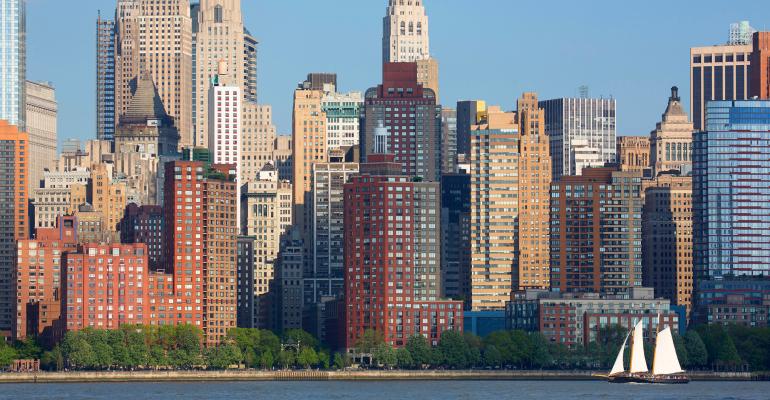Once again, "the rent is too damn high" in New York City.
For a brief moment during the coronavirus pandemic, renters could find steep discounts on New York City apartments. Property managers in Manhattan’s urban core, for example, offered as much as three or even four months of free rent to tenants who signed a one-year lease.
Those times are over. New York City rents not only fully climbed back to pre-pandemic levels but are not soaring to new all-time highs. The city's population, after all, shrank during the pandemic. So, once again, renters are struggling to understand what is driving the hot market. Are too many units being taken off the rental market and run as airbnbs? Is the for-sale market taking away rental supply? And if a global pandemic could not solve the housing crisis in New York, what can?
Economists say the most important thing New York City can do to help it ease its housing crisis is encourage the construction of more new apartments—but that might become more difficult program to support new development, like the city’s 421-a property tax exemption, are allowed to expire.
“It’s fundamental that a chronically undersupplied housing market like New York sees new construction to alleviate the broader issue of housing shortage,” says Carl Whitaker, director of research and analysis for RealPage, Inc.
High rents again in NYC
Apartments now rent for more than they did before the pandemic. Deals like months of free rent are once again hard to find.
The average apartment rented for $4,161 in May 2022 in the New York City and White Plains metropolitan statistical area, according to RealPage, which typically collects data from professionally-managed properties with more than 50 rental units. That high rent is up from $3,718 in February 2020.
"New York was one of the last markets to recover to its pre-pandemic rental rate, today’s rate is about 12 percent above that pre-pandemic mark," says Whitaker. "For comparison, the U.S. overall is about 21 percent above."
More than 97 percent of New York apartments were occupied in June 2022—that’s higher than the occupancy rate before the pandemic, according to RealPage. “That points to stronger demand from new leases as well as stronger ‘backdoor’ demand seen in retention rates,” says Whitaker. Two-thirds (64 percent) of expiring resident leases were renewed so far in the second quarter of 2022, up from less than half during the pandemic.
Rent stabilized apartments protect renters and still attract investors
Thousands of New Yorkers are protected from sharply rising rents by rent stabilization laws that got a lot tougher in 2019.
But investors still pay high prices for rent-stabilized apartments, even though the properties no longer make sense as “value-added” investments. Owners can no longer renovate and use the cost of renovations as a justification to sharply raise rents and eventually leave the rent stabilization program. These rent-stabilized properties can still provide dependable income, somewhat like the yield from a Treasury bond.
“Investors view rent-stabilized portfolios more as a yield play than a growth story,” says Matthew Klauer, senior vice president in debt and structured finance for CBRE. “Rent stabilized units provided an extremely consistent stream of rental revenue and experience far lower turnover than market-rate rental product.”
Developers build new apartments in changing neighborhoods
Developers were building 33,000 new apartments in the City in early 2022—equal to about 2 percent of the existing inventory, according to RealPage. That’s not enough new construction to force property managers to cut rents or offer deep concessions to fill vacant units.
“Overbuilding doesn’t appear to be much of a concern,” says Whitaker
However, developers have been busier in New York City in the last five years than any other period in a long time. “The result has been the development of class-A rental product in all boroughs and the gentrification of numerous submarkets that had been neglected for decades,” says CBRE’s Klauer.
Housing advocates are putting some on the blame for the shortage of available rental apartments on websites like airbnb or Vrbo. In May, 14,870 different apartments and houses were offered for at least one night on these sites over the month ending June 7, 2022, according to airdna.com. About a quarter (24 percent) of those listings had been available to rent for at least 181 days over the last year—these listings may represent several thousand apartments that could be leased by conventional renters. However, these thousands of apartments represent less than 1 percent of the City’s total inventory of 1.91 million rental apartments, according to RealPage.
“Removing any inventory for the purpose of long-term rentals in lieu of a short-term rental does exacerbate housing shortages,” says Whitaker. “There’s some measurable impact simply due to just how tight the housing market in NYC is to begin with.”
Programs to encourage development might expire
Housing advocates also worry that programs that support new development might be about to vanish.
The Affordable New York program, also known as 421a tax exemption, is currently set to expire on June 15, 2022. If the program dies, developers will need to have started construction on or before the June 15, 2022, deadline to obtain the exemption for a portion of their property taxes from a new building.
Experts says that many rental developments might not make sense without the tax break, incentivizing developers to use their land to build luxury condominium buildings instead.

